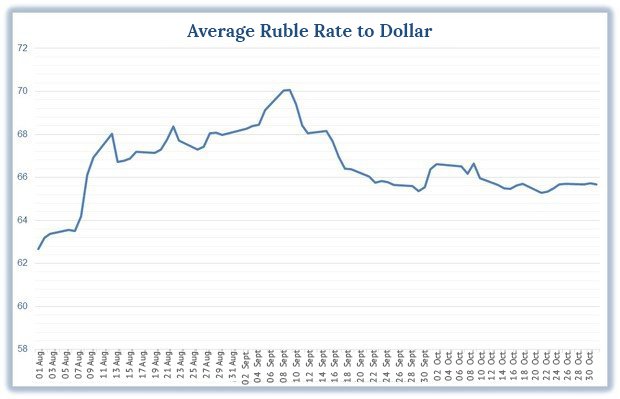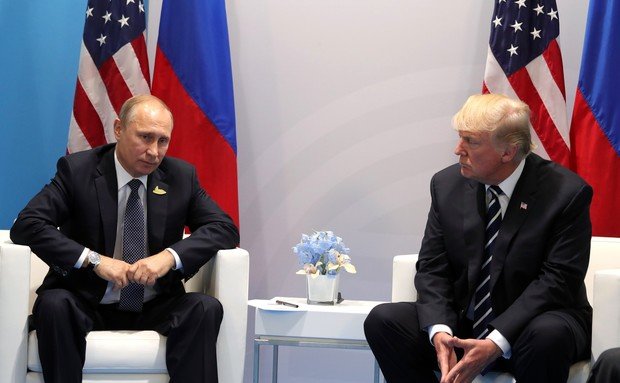End of silence. November might decide the ruble’s fate
New trials await the Russian currency after October lull
November might become a decisive month for the ruble rate till the end of 2018: the Russian currency will have to face consequences of the election to the US Congress. A new wave of negativism can arise after an October lull in sanctions and the tax payment period. However, there are chances to get stronger in the best-case scenario. Realnoe Vremya tells the details.
Calm October
October ended without emotional shocks in the financial market. The ruble was lower than 66 rubles/$ or, more precisely, in the diapason of 65,3-65,7/$ in the second half of the month. The negative news from the USA didn't disturb the lull: a new round of ''sanctions from the hell'' awaited the market only in November. Moreover, a reason for a short-term positive appeared in late October: US President's adviser John Bolton claimed Washington wasn't considering additional sanctions on the Skripal case.
The ruble kept receiving support from oil prices. In September, a barrel of Urals was 1,4 times higher than in the analogous month in 2017. In January-September, in general, the average price exceeded last year's price by 39,7%. The moratorium on currency interventions the Central Bank promised to stick to till the end of the year was the recipe for stability.
Powerful data on Russia's payment balance for the third quarter were ready in early October – current transactions' surplus totalled $26,4bn against a $3,2bn deficit a year ago. Finally, the tax payment period was an additional stimulus for the Russian currency.

Peace breakers
But peace might come to an end. In Alfa-Bank analysts' opinion, the first decade of November will be probably decisive and define the dynamics of the rate till the end of 2018. Mid-term election to the US Congress was on 6 November, and many analysts forecast further sanction-related decisions will depend on its outcome. According to some forecasts, the sanction rhetoric might become tougher after the election. If sanctions aren't announced in the next several weeks, the chances for a firmer ruble will grow, Alfa-Bank notes. Vladimir Putin and Donald Trump's meeting was scheduled for 11 November.
The presidents of the countries were to meet in Paris to mark the 100 th anniversary of the end of the First World War. ''It will be a normal bilateral meeting,'' Putin's aide Yury Ushakov said. According to him, the meeting wasn't supposed to have a big delegation, but ''key representatives from both sides'' were expected. John Bolton, in turn, has recently supposed the meeting is likely to be short. Now the meeting has been deferred indefinitely, which raises the ''degree of expectations''.
Previously, the leaders of Russia and the USA met only once for bilateral talks – this July in Helsinki. This is why many people think the market's moods and particularly the situation with the ruble will depend on how the new meeting will look and when it will be.

Up or down
Promsvayzbank's leading analyst Mikhail Poddubsky thinks the November events might influence the ruble only in the short term – in the long term, everything depends on the situation in developing markets. According to him, now the ruble is highly correlating with all currencies of developing countries. And calm October is a general tendency for them.
''As for the election and the meeting of Putin and Trump, undoubtedly, we should keep them in mind, and volatility of the Russian currency can probably somehow grow after these events. But if we're talking about from a perspective of a month, general tendencies are more important anyway.''
 ''In our opinion, the ruble has been underestimated at the moment. Theoretically, these is some potential for growth, but it's hard until there is a positive in all currencies of developing countries and sanctions are imposed. This doesn't allow the ruble to be at the level that can be considered fair,'' Poddubsky adds.
''In our opinion, the ruble has been underestimated at the moment. Theoretically, these is some potential for growth, but it's hard until there is a positive in all currencies of developing countries and sanctions are imposed. This doesn't allow the ruble to be at the level that can be considered fair,'' Poddubsky adds.
''Unfortunately, we don't expect positive changes,'' says Investment Director at General Invest Denis Gorev. ''We unlikely should wait for the sanction rhetoric to weaken – therefore, the pressure on the ruble will remain quite strong till the end of the year. In case of the negative development of events (more severe sanctions), we expect to see the ruble at 72-75 rubles per dollar.''
''In any case, the ruble won't stay at the current level. Of course, there will be volatility both before and after the election,'' Deputy Direct at Finam IC Yaroslav Kabakov is sure. According to his estimate, the diapason of fluctuations might vary from 61 to 68 rubles per dollar. The ruble can become both firmer (if the Republicans win) and weaker (if the Democrats win) in this corridor.